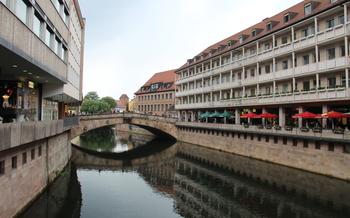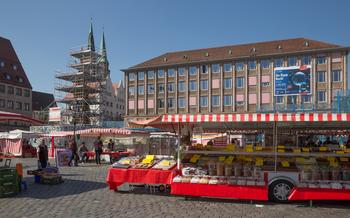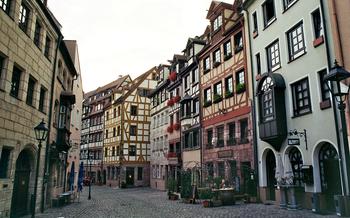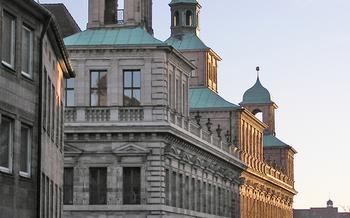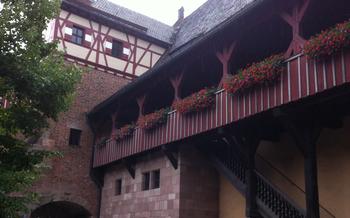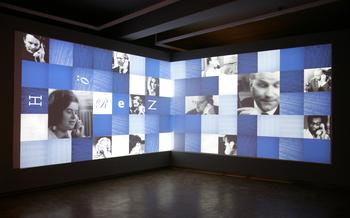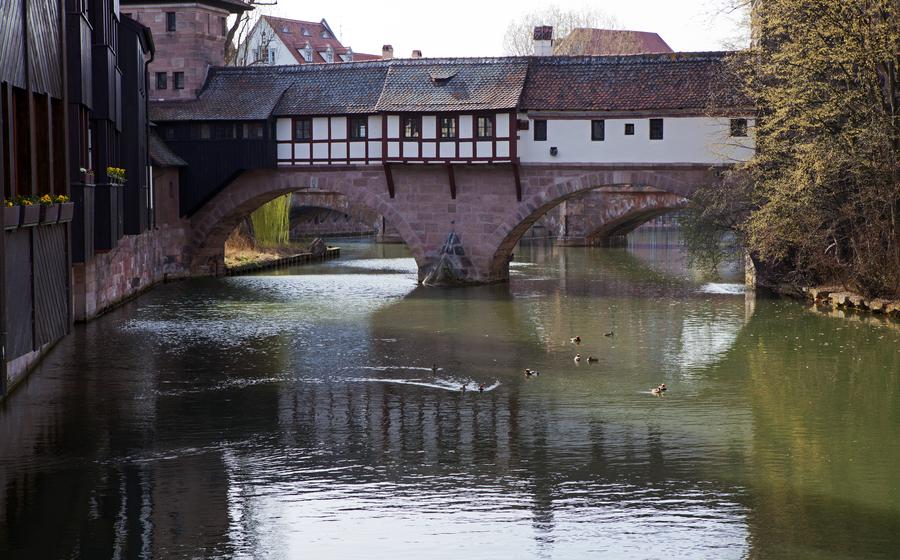
Henkersteg and Henkerhaus
- The Henkersteg
- The Henkerhaus
- The Henkersteg Today
- The Henkerhaus Today
- The Executioner's Legacy
- Crime and Punishment in Medieval Nuremberg
- The Executioner's Sword
- The Executioner's House Museum
- Visiting the Henkersteg and Henkerhaus
- Insider Tip:
The Henkersteg
The Henkersteg, also known as the Executioner's Bridge, is a historical landmark in Nuremberg, Germany, with a captivating backstory. The bridge's intriguing history is intertwined with the city's executioner's house, the Henkerhaus, and its role in the city's defense system and trade routes.
Built in the 14th century, the Henkersteg served as a vital connection between the city center and the executioner's house, situated on the opposite side of the Pegnitz River. The bridge's sturdy stone construction and strategic location made it an integral part of Nuremberg's defense system, allowing for swift troop movement and access to the city gates.
In addition to its defensive role, the Henkersteg played a crucial role in the city's trade routes. Nuremberg's thriving economy relied heavily on the transportation of goods, and the bridge served as a vital artery for merchants and traders traveling to and from the city. Its proximity to the executioner's house, where criminals were often publicly executed, created an eerie and somber atmosphere that added to the bridge's notoriety.
Over the centuries, the Henkersteg has accumulated a wealth of anecdotes and legends. One famous tale speaks of a young woman who was unjustly accused of witchcraft and sentenced to death. As she crossed the bridge on her way to her execution, she cursed the city of Nuremberg, declaring that the bridge would forever be haunted by her spirit. To this day, some claim to have seen her ghost wandering the bridge, seeking vengeance for her tragic fate.
The Henkerhaus
The Henkerhaus, also known as the Executioner's House, stands as a testament to the dark and macabre history of Nuremberg. This unassuming building, located near the Henkersteg, was the residence of the city's executioner from the 13th to the 19th century. It is a chilling reminder of the role that capital punishment played in medieval society.
The executioner's house is a three-story building with a dark and foreboding exterior. The ground floor served as the executioner's workshop, where he sharpened his tools and prepared for his grisly tasks. The upper floors were his living quarters, where he lived with his family. The house also had a stable for the horse that pulled the executioner's cart.
Visitors to the Henkerhaus can learn about the history of executioners in Nuremberg and the role they played in society. The house is now a museum, showcasing a collection of artifacts and exhibits related to the executioner's profession. Guided tours are available, providing visitors with a glimpse into the life of the executioner and the dark history of Nuremberg.
The Henkersteg Today
The Henkersteg has undergone extensive preservation and restoration efforts to maintain its historical integrity. As a result, it stands today as a testament to Nuremberg's rich and often dark past. The bridge is a popular tourist attraction, drawing visitors from around the world who come to admire its unique architecture and learn about its grim history.
The bridge's current status as a historical landmark is a far cry from its original purpose as a crossing point for the city's executioner. Today, it serves as a symbol of Nuremberg's past and its commitment to preserving its history, regardless of how unsavory it may be.
In modern-day Nuremberg, the Henkersteg is a place of reflection and remembrance. It is a reminder of the city's dark past and the role that the executioner played in maintaining law and order. The bridge serves as a reminder of the importance of justice and the need to uphold human rights, even in the face of adversity.
Various events and activities are held on or around the bridge throughout the year. These events often focus on the history of the bridge and its connection to the executioner's house. They provide an opportunity for visitors to learn more about this unique aspect of Nuremberg's past and to engage in discussions about justice, punishment, and the role of the executioner in society.
The Henkerhaus Today
The Henkerhaus, once a place of fear and dread, has undergone a remarkable transformation. Today, it serves as a museum and cultural center, shedding light on the history of executioners and capital punishment in Nuremberg. The building's somber exterior belies a rich and complex interior, where visitors can explore interactive exhibits and educational displays that delve into the lives and work of Nuremberg's executioners.
The museum's collection includes a variety of artifacts and documents related to the executioner's profession, such as executioner's swords, hooded robes, and instruments of torture. Visitors can learn about the executioner's role in medieval Nuremberg society, the methods of execution used during that time, and the challenges and difficulties faced by executioners and their families.
The Henkerhaus also hosts temporary exhibitions and events that explore different aspects of capital punishment and its history. These exhibitions often feature works of art, historical documents, and interactive installations that encourage visitors to reflect on the complex issues surrounding capital punishment and its abolition.
Through its exhibitions and educational programs, the Henkerhaus aims to promote dialogue and understanding about this controversial topic. It challenges visitors to confront their own biases and prejudices and to consider the human toll of capital punishment, both for those who were executed and for those who carried out the sentences.
The Executioner's Legacy
The executioner's role in Nuremberg's history has left a lasting legacy that continues to fascinate and intrigue to this day. The city's efforts to preserve and commemorate this unique aspect of its past are evident in the Henkersteg, Henkerhaus, and the Executioner's Legacy Trail. These sites serve as a reminder of the complex and often dark realities of medieval justice, while also highlighting the changing attitudes towards crime and punishment over time.
The figure of the executioner remains a controversial and compelling subject in popular culture, inspiring countless works of literature, film, and art. The executioner's unique position on the fringes of society, wielding both power and stigma, has captured the imagination of storytellers for centuries. Their tales often explore themes of justice, morality, and the human condition, using the executioner as a lens through which to examine the darker aspects of human nature.
In Nuremberg, the executioner's legacy is inseparable from the city's own history. The Henkersteg and Henkerhaus stand as tangible reminders of a time when public executions were a common occurrence, and the executioner played a vital role in maintaining law and order. By preserving and interpreting these sites, Nuremberg acknowledges its dark past and invites visitors to confront the complexities of crime and punishment in medieval society.
Crime and Punishment in Medieval Nuremberg
During the Middle Ages, Nuremberg, like many other cities in Europe, experienced high levels of crime and harsh punishments. The executioner played a central role in maintaining law and order, carrying out the sentences imposed by the city council. Common offenses included theft, assault, and murder, but even minor infractions could result in severe penalties. For example, petty theft might be punished by whipping or branding, while more serious crimes could lead to imprisonment, mutilation, or even death.
The judicial process in Nuremberg was complex and involved several stages. Accused individuals were first brought before a local court, where they were examined and questioned. If there was sufficient evidence against them, they would be transferred to the city council for further investigation and trial. The council would then decide on the appropriate punishment, which would be carried out by the executioner.
The executioner's duties extended beyond carrying out executions. He was also responsible for torturing prisoners to extract confessions or information, and for disposing of the bodies of criminals. In some cases, the executioner might also be called upon to act as a public health official, removing dead animals or cleaning up after epidemics.
The Executioner's Sword
The executioner's sword held a profound symbolic significance, representing the authority and power of the city council and the executioner's role as an agent of justice. These specialized weapons were meticulously crafted, often by skilled blacksmiths, and designed to deliver a swift and precise death blow. The blades were typically long and sharp, with a single or double-edged design. The hilts were often elaborately decorated with intricate carvings, engravings, or symbols related to justice or death.
The executioner's sword played a central role in public executions, where it was used to behead or decapitate condemned criminals. The sword was also used in ceremonial contexts, such as when the executioner was sworn into office or when a new sword was presented to the city council.
One notable anecdote about the executioner's sword involves the execution of a man named Hans Schmidt in 157Schmidt was accused of murdering his wife and was sentenced to death by beheading. The executioner, Franz Schmidt, was known for his skill with the sword and was said to be able to sever a head with a single stroke. However, on this occasion, Franz Schmidt's sword became stuck in the man's neck, and he had to struggle to free it. This incident caused a great deal of commotion and embarrassment, and Franz Schmidt was subsequently dismissed from his position as executioner.
The executioner's sword remains a powerful symbol of the city's dark history and the role of the executioner in medieval Nuremberg. Today, it is displayed in the Executioner's House Museum, where visitors can learn more about its significance and the stories behind it.
The Executioner's House Museum
The Executioner's House Museum, located in the historic building that once housed the city's executioner, offers a unique and immersive experience for visitors interested in the dark and fascinating history of Nuremberg. The museum houses a collection of artifacts, documents, and interactive exhibits that shed light on the role of the executioner in medieval society and the city's justice system.
Visitors can learn about the various methods of execution used during the Middle Ages, the executioner's relationship with the city council and authorities, and the social stigma associated with the profession. The museum also explores the lives of famous executioners who served in Nuremberg, their contributions to the city's public safety, and the controversial cases they oversaw.
Guided tours are available to provide visitors with a deeper understanding of the museum's exhibits and the history of the executioner's profession. Educational programs and workshops are also offered, allowing visitors to engage with the museum's collection and learn more about this often-overlooked aspect of Nuremberg's past.
The Executioner's House Museum is a valuable resource for anyone interested in exploring the darker side of Nuremberg's history. It offers a unique perspective on the role of the executioner in medieval society and the lasting impact of this controversial profession on the city's culture and identity.
Visiting the Henkersteg and Henkerhaus
To delve into the captivating history of the Henkersteg and Henkerhaus, plan your visit carefully. The Henkersteg is accessible 24 hours a day, allowing you to admire its architectural beauty at any time. The Henkerhaus, now a museum, welcomes visitors from Tuesday to Sunday, with guided tours available in German and English. Admission fees are reasonable, and guided tours provide an in-depth understanding of the site's history.
To fully appreciate the significance of these landmarks, consider combining your visit with a guided walking tour that explores Nuremberg's dark history. These tours often include stops at the Henkersteg and Henkerhaus, providing a comprehensive overview of the city's past. Many tours are available in different languages, ensuring that international visitors can also delve into Nuremberg's fascinating history.
For a truly immersive experience, plan your visit around one of the many events and activities held on or around the Henkersteg. These events often showcase medieval reenactments, historical demonstrations, and cultural performances, bringing the past to life in a captivating way. Check the Nuremberg tourism website for upcoming events and festivals.
Before your visit, consider exploring the Executioner's Legacy Trail, a self-guided walking tour that takes you to various sites associated with the executioner's profession in Nuremberg. This trail provides a deeper understanding of the executioner's role in the city's history and is a great way to complement your visit to the Henkersteg and Henkerhaus.
Insider Tip:
For a truly immersive experience, consider booking a guided tour of the Executioner's House Museum. Led by knowledgeable historians, these tours provide a fascinating glimpse into the lives and duties of Nuremberg's executioners. You'll learn about the methods of execution, the social stigma associated with the profession, and the challenges faced by the executioner's family. The tour also includes a visit to the museum's collection of artifacts, including executioner's swords, torture devices, and historical documents. It's a unique opportunity to gain a deeper understanding of this dark chapter in Nuremberg's history.
After your visit, be sure to explore the surrounding area. Just a short walk away is the beautiful Frauentorstrasse, with its colorful half-timbered houses and charming shops. Here, you can find a variety of restaurants and cafes to enjoy a traditional Nuremberg meal or a refreshing drink.
